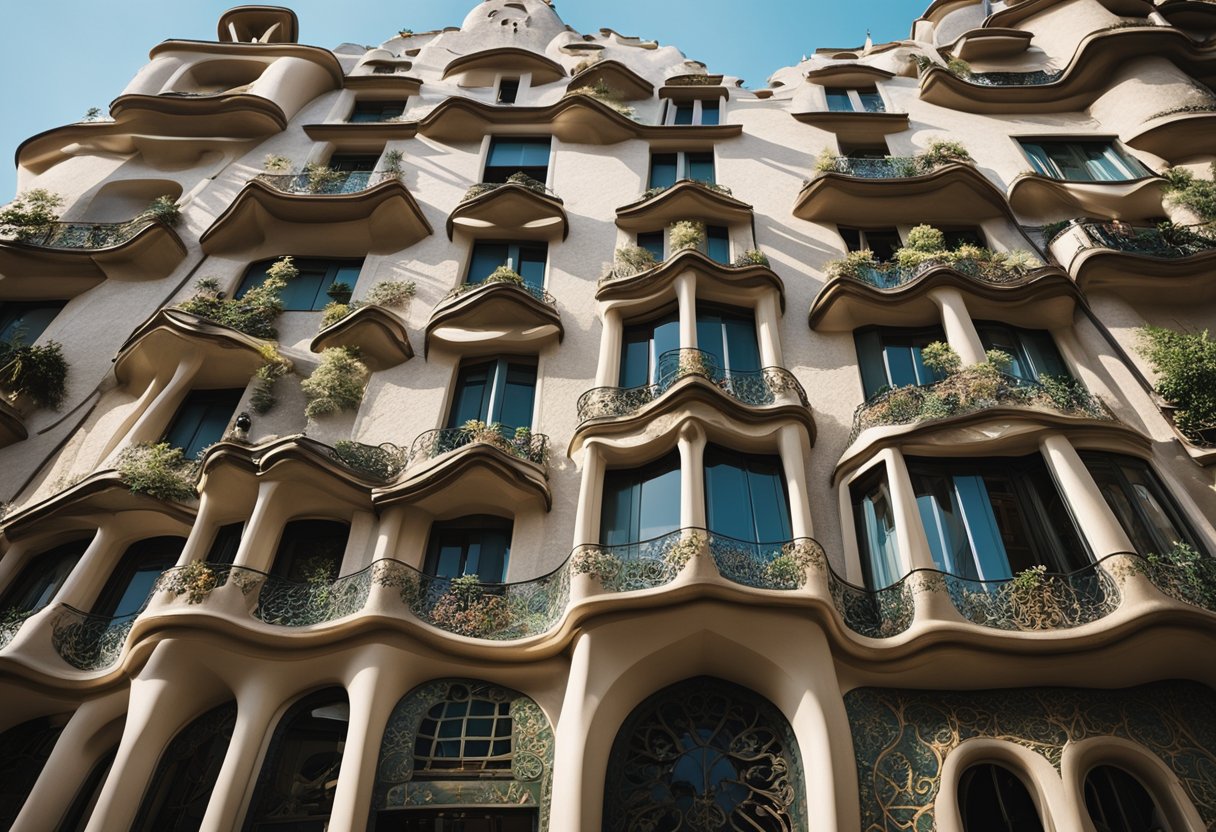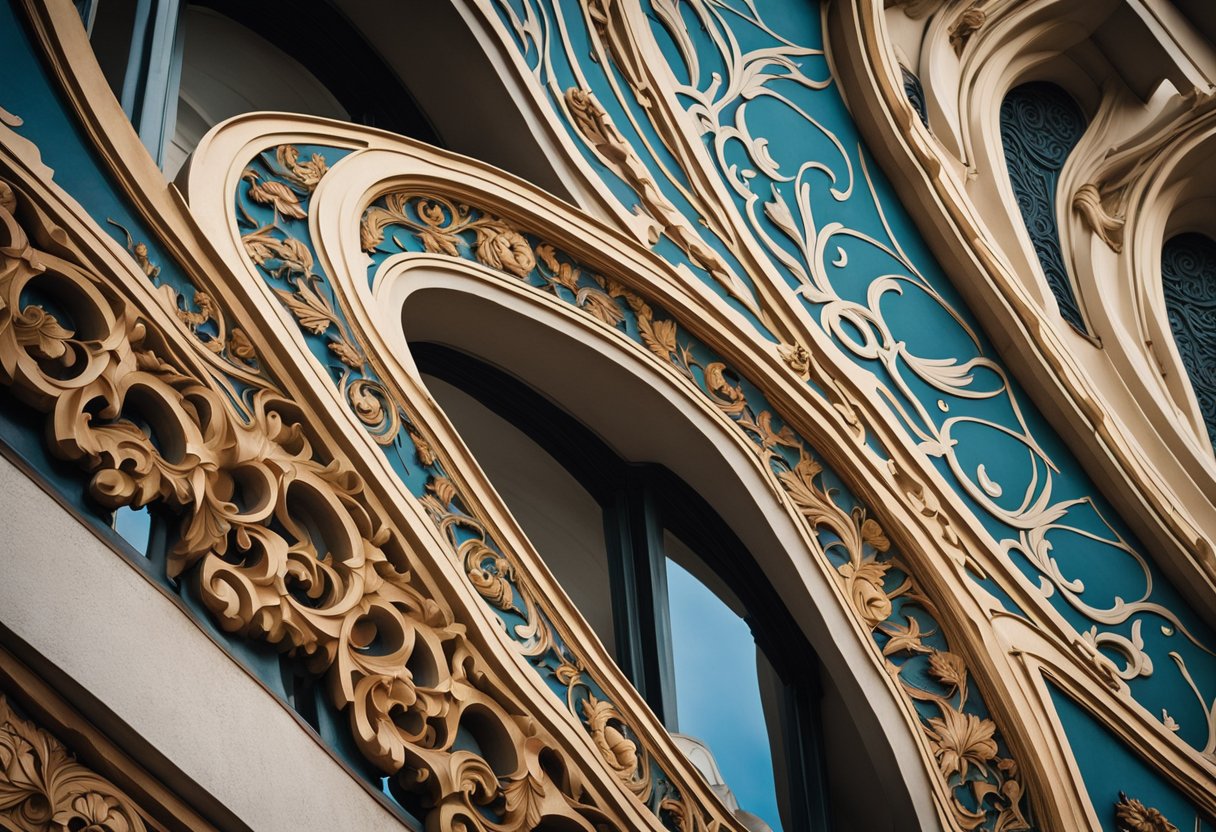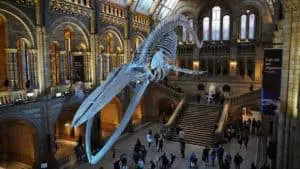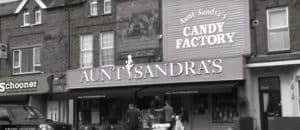The Art Nouveau Movement: Journey Across Europe

Updated On: April 16, 2024 by Eman Sameh
At the turn of the 20th century, a captivating aesthetic began to sweep across Europe, leaving a trail of elaborate tendrils and organic forms in its wake. Known as Art Nouveau, this movement signalled a departure from the traditional, embracing a philosophy that sought to blur the lines between fine arts and applied arts. From the undulating façades of Barcelona to the Stoclet Palace in Brussels, the Art Nouveau movement was not merely a style; it was an ideology that permeated architecture, interior design, and decorative arts. Its novelty resonated with the spirit of modernity, echoing across the continent from bustling metropolises to modest towns.
The roots of Art Nouveau can be traced back to a reaction against the academic art and impersonal mechanisation of the Industrial Age. Artists and designers aimed to harmonise with the natural environment, which is why the movement is characterised by flowing lines, floral motifs, and a palpable sense of rhythm and movement within designs. Each European city expressed Art Nouveau differently, moulding its principles to their local tradition and sentiments, resulting in a mosaic of distinctive styles. Barcelona’s Modernisme boasted the dreamlike works of Antoni Gaudí, whereas Budapest proudly presented Ödön Lechner’s national romanticism twist.
Historical Context of Art Nouveau

As we explore the historical context of Art Nouveau, we focus on how this artistic movement was a turning point in the intersection of decorative and fine arts, influenced by a variety of stylistic sources and cultural developments, which peaked at the dawn of the 20th century before its eventual decline.
Influences and Precursors
Art Nouveau emerged as a dynamic art movement in the late 19th century, a time when Europe was witnessing a blend of innovative ideas and stylistic revolutions. One significant precursor to Art Nouveau was the Arts and Crafts Movement, which commenced in England. This movement was a reaction against the soulless machine-made production of the Industrial Revolution, advocating a return to handcrafted artisanship and finer, detailed work.
Another essential influence on Art Nouveau was Japonism, which was the appreciation and imitation of Japanese art and design. This affinity for Japanese aesthetics introduced new themes and visual expressions into European art, characterised by fluid lines and an emphasis on nature. The movement also drew upon elements of Modern Art, breaking away from the rigid constraints of traditional academic art and pursuing innovation in design and execution.
Art Nouveau’s Peak and Decline
Art Nouveau reached its apex between approximately 1890 and 1910. During this “Belle Époque”, European cities like Barcelona and Budapest were adorned with buildings and public spaces designed in the Art Nouveau style, showcasing the sinuous lines and natural forms that have become its hallmark.
However, the onset of World War I marked a significant shift in societal needs and tastes, leading to Art Nouveau’s decline. The movement was criticised for its elaborate ornamentation, which was increasingly seen as impractical amid the advances of modernism and the changing times. By the 1920s, Art Nouveau had given way to new design philosophies, including Art Deco and the International Style, which prioritised functionalism over elaborate aesthetics.
Characteristics and Philosophy

In delving into the movement, we uncover a movement steeped in a distinctive ethos and aesthetic. This section dissects the philosophy and the defining features of the artistic phenomenon as it blossomed from Barcelona to Budapest, spotlighting its commitment to unity in art and a natural, flowing form.
Form and Function
We see that Art Nouveau combined form and function with an intent to harmonise the two. Everyday objects weren’t merely utilitarian but were crafted with the ethos of ‘total art’, where beauty and usability merged seamlessly. Furniture, glassware, and buildings bore the distinctive curves and contours emblematic of the movement, underlining the principle that practical items should also be aesthetically pleasing.
Nature and Organic Forms
The Art Nouveau style is synonymous with nature and organic forms. It favoured motifs drawn from the natural environment, embracing sinuous curves reminiscent of plant stems, vine tendrils, and floral patterns. This preference for organic forms was not arbitrary; rather, it epitomised a deeper philosophical inclination towards embodying the natural world’s intrinsic beauty and rhythm in art and architecture.
Symbolism and Ornamentation
Our exploration of the movement uncovers rich layers of symbolism and ornamentation. The movement frequently employed ornate detailing not just for embellishment but also as a symbolic language. Illustrative and metaphorical, the ornament was embedded with meanings, often alluding to themes of renewal and the cyclical nature of life, indicated by the recurrent use of floral and natural motifs.
Major Art Nouveau Cities and Their Unique Styles

Art Nouveau was a distinguished and ornamental style that emerged at the end of the 19th century. This style blossomed in various European cities, each adding a unique twist to their architectural and decorative arts.
Paris: Hector Guimard and the Métro Entrances
In Paris, Hector Guimard became a leading figure by designing the iconic green, sinuous cast-iron Métro entrances. These structures are emblematic of the French approach to Art Nouveau, often referred to as Style Guimard.
Barcelona and the Work of Antoni Gaudí
Barcelona’s take on the movement, known as Modernisme, was significantly shaped by Antoni Gaudí. His masterpieces, including the Sagrada Família and Casa Batlló, highlight organic forms and vibrant patterns that are hallmarks of Catalan Modernism.
Brussels’ Victor Horta and Henry van de Velde
In Brussels, architects like Victor Horta and Henry van de Velde championed the Belgian variant of Art Nouveau. Horta’s Hôtel Tassel and Hôtel Solvay are celebrated for their innovative use of iron and glass, along with nature-inspired lines.
Vienna’s Gustav Klimt and Jugendstil
Vienna witnessed the rise of the Vienna Secession, with artists like Gustav Klimt at its helm. The movement, part of Jugendstil, gave birth to works featuring intricate linear designs and the union of fine and applied arts, evident in buildings like the Secession Hall.
Budapest and Ödön Lechner’s Hungarian Take
Ödön Lechner, often called ‘the Hungarian Gaudí’, infused traditional Hungarian motifs with Art Nouveau, producing a distinctive local version known as Szecesszió. Notable buildings in Budapest display vibrant Zsolnay ceramic tiles and echo folk art patterns.
Art Nouveau Across Different Art Forms
Art Nouveau showcased its distinct, organic aesthetic through various mediums, seamlessly integrating art with everyday life. The movement’s emphasis on unity in design led to cohesive artistic expression across both the fine arts and applied arts.
Graphic Arts and Illustration
In graphic arts, the movement brought forward a unique visual language marked by elongated lines and natural motifs. Illustrators like Aubrey Beardsley capitalised on the movement’s penchant for distinct linear rhythms and flat, unmodulated colour areas to create influential works. This style influenced the production of posters, advertisements, and book illustrations, bridging the gap between commercial needs and artistic pursuits.
Furniture and Interior Design
For furniture and interior design, Art Nouveau innovators such as Charles Rennie Mackintosh, associated with the Glasgow Style, developed pieces that were as much sculptural as functional. Our interiors saw a symphony of geometric forms and stylised natural elements, with furniture that often bore the sinuous lines and floral patterns characteristic of the movement, creating harmonious and organic living spaces.
Architecture
The field of architecture was revolutionised by figures like Antoni Gaudí in Barcelona and Ödön Lechner in Budapest, who infused buildings with Art Nouveau’s signature curvilinear forms and unprecedented structural innovations. Architects embraced new materials such as iron and glass to create iconic and visually striking façades and structures. From the Casa Batlló in Barcelona to the Paris Métro entrances designed by Hector Guimard, the movement’s imprint on the urban landscape was profound and lasting.
Decorative and Applied Arts
The decorative and applied arts flourished under the movement, with artists and craftsmen producing objects that were both beautiful and practical. This included glass art by Louis Comfort Tiffany and ceramics that often featured iridescent glazing and flowing natural shapes. Each piece, be it in glass art or ceramics, elevated mundane functions to an art form, embodying the movement’s belief that beauty should permeate every aspect of life.
Notable Art Nouveau Artists and Their Works

During the Art Nouveau period, several artists distinguished themselves through their innovative and iconic designs. We’ll focus on three key figures who each brought their own flavour to the movement with trailblazing works across various mediums.
Alphonse Mucha and Graphic Arts
Alphonse Mucha, a Czech painter and decorative artist, is best remembered for his distinctive style in posters, advertisements, and illustrations, which epitomise the Art Nouveau aesthetic. His designs for magazine covers, advertising posters, and book illustrations feature sinuous lines, natural elements, and enchanting female figures. Perhaps one of his most famous works is the ‘Gismonda’ poster for actress Sarah Bernhardt, which catapulted him into the limelight.
Louis Comfort Tiffany and Glasswork
American artist Louis Comfort Tiffany contributed to the movement through his stunning glass art. Tiffany’s innovation in glasswork, especially his stained glass windows and lamps, showcases the movement’s love for organic shapes and the interplay of light and colour. His designs elevated glasswork from mere craftsmanship to an art form, with pieces like the Tiffany lamp still celebrated today.
Charles Rennie Mackintosh and the Glasgow Style
Scottish architect and designer Charles Rennie Mackintosh’s works are foundational to the ‘Glasgow Style’ within Art Nouveau. Not merely content with pen and paper, he extended his reach to furniture design and architecture, offering a more geometric counterpoint to the otherwise curvilinear trend of the time. Prominent works, including the Glasgow School of Art, illustrate his unique ability to blend natural motifs with bold lines for an unmistakable aesthetic.
The Global Spread of Art Nouveau
Art Nouveau’s distinctive style rippled beyond its European origins, marking its presence from bustling North American cities to the intricate designs adorning Italian architecture. The movement, blending natural forms with geometric structures, truly became a universal language of aesthetics and design.
Influence on North American Design
In the United States, Art Nouveau made a noticeable impact on both graphic and architectural designs. Tiffany & Co., with their iconic lamps, is a prime example of this style’s integration into American craftwork. Innovatively, they applied the movement’s aesthetics to create objects characterised by fluid lines and natural motifs that symbolised luxury and sophistication.
Art Nouveau in Italy and Stile Liberty
Italy embraced Art Nouveau, known locally as Stile Liberty, after the famed London department store Liberty & Co., which extensively promoted the style. Italian architects translated Art Nouveau’s essence into grand and ornate structures such as the Casa Fenoglio-Lafleur in Turin, reflecting a penchant for the movement’s flourishing in urban Italian facades.
Jugendstil’s Emergence in Germany and Austria
Jugendstil, the term used in Germany and Austria, emerged contemporaneously as a parallel to Art Nouveau. Vienna became a hub for Jugendstil, with artists such as Gustav Klimt pushing the movement’s boundaries. Architect Otto Wagner’s work in Vienna, including the Majolica House and the Karlsplatz Stadtbahn Station, embodies the Jugendstil commitment to functionality draped in artistic elegance.
Materials and Techniques in Art Nouveau
Art Nouveau’s distinct style is partly owed to the innovative use of materials such as iron, glass, and ceramics and to the advanced techniques that allowed them to be transformed into intricate designs.
Innovations in Ironwork
Art Nouveau ironwork showcased the material’s versatility, moving away from traditional structural uses to more ornamental and expressive forms. Iron was skilfully wrought into fluid, organic shapes, often imitating the lines of plants and natural forms. Notable examples include the Paris Métro entrances designed by Hector Guimard, which feature sinuous iron forms that have become icons of Art Nouveau design. Such ironwork was not purely decorative; it often played a structural role in buildings, merging functionality with aesthetics.
Exploring Ceramics and Glass
Ceramics were another cornerstone of the Art Nouveau movement, with terracotta and majolica being used extensively for architectural decoration. French artist Louis Majorelle was renowned for leveraging these materials, crafting furniture and objects that embodied the movement’s aesthetics. His work represents a synergy between artistic flair and functional design.
Glass art also flourished during this period, with stained glass windows becoming a hallmark. The technique involved arranging coloured glass pieces into intricate patterns, often depicting natural scenes and floral patterns. Art Nouveau’s use of glass extended to lighting fixtures and decorative objects, with artists experimenting with new methods to manipulate its translucency and reflective properties, thereby creating a play of light and colour that was both innovative and mesmerising.
Transition to Modernism and Relation to Other Movements
Art Nouveau served as a bridge into modernism while maintaining a relationship with previous styles, such as the Arts and Crafts Movement, and it significantly influenced subsequent movements such as Art Deco.
Connections with the Arts and Crafts Movement
Art Nouveau and the Arts and Crafts Movement both reacted against the effects of the Industrial Revolution on design. They shared a commitment to high-quality craftsmanship and the beauty of hand-crafted products. However, where the Arts and Crafts Movement emphasised traditional forms and techniques, Art Nouveau embraced new materials and organic forms. The idea of the ‘total work of art’ or Gesamtkunstwerk became a shared principle, striving for a harmonious design that unites all forms of art.
Art Nouveau’s Influence on Art Deco and Modernism
Following Art Nouveau, the Art Deco movement arose, initially capturing the world’s attention at the 1925 Exposition Internationale des Arts Décoratifs et Industriels Modernes in Paris. Art Deco reflected the modern age with geometric shapes, a stark contrast to Art Nouveau’s curvilinear motifs. Nevertheless, Art Nouveau’s emphasis on integrating art with daily living paved the way for Modernism and institutions like the Bauhaus, which sought to fuse art, craftsmanship, and technology. Both Art Deco and Modernism carried the legacy of Art Nouveau’s innovative spirit into new realms of expression in the early 20th century.
Preservation and Legacy

The quest to safeguard Art Nouveau’s vibrant legacy is an ongoing endeavour, ensuring that the enchanting aesthetics of the movement remain an integral part of Europe’s architectural and cultural identity.
Art Nouveau Today: Heritage and Revival
Art Nouveau remains a cherished part of our cultural heritage, evident through the concerted efforts to preserve notable structures that continue to mesmerise enthusiasts and scholars alike. The ethos of this style is closely tied to the principles of organic design and a whimsical escape from the rigidity of industrialisation, and as such, it is considered a predecessor to modern art movements.
Throughout Europe, cities are proud custodians of Art Nouveau heritage, with prominent museums and ongoing restorative initiatives maintaining the splendour of important monuments. Barcelona, with its Gaudí masterpieces and Budapest, boasting exceptional examples of this ornate style, serve as key hubs where Art Nouveau architecture attracts worldwide admiration and visitation.
On a broader canvas, the movement’s revival can be observed in various forms – ranging from contemporary decorative arts that echo characteristic Art Nouveau motifs to educational endeavours. The Art Nouveau Across Europe (Online) course at Oxford University epitomises such scholarly pursuits, ensuring a new generation understands and values the historical context and aesthetic principles that shaped the movement.
Despite the advent of the Bauhaus movement, which marked a shift towards more functional and simplified forms, Art Nouveau’s intricate designs and elaborate detailing have seen a resurged appreciation in the modern era. As we champion Art Nouveau’s conservation, we safeguard a pivotal chapter in our artistic evolution—one that defied conventions and paved the way to modernism.
Impact of Art Nouveau on Fashion and Lifestyle
In the immersive world of Art Nouveau, the intersection between art and everyday life was resplendent. We witnessed a seamless blend between aesthetic elegance and practical living as the movement left its indelible mark on fashion and lifestyle across Europe.
Fashion embraced the sinuous lines and natural forms characteristic of Art Nouveau, integrating these into garments and accessories. Clothing became a canvas for artistic expression, adorned with the fluid curves of vines and the natural palettes so beloved by the movement, which brought a sense of harmony and fluidity to the silhouette. Organic motifs, such as leaves and flowers, often found their way into elaborate prints and embellishments, infusing everyday wear with an artistic flourish.
Lifestyle, too, was touched by the movement’s preference for synthesis between form and function. The domestic environment transformed under Art Nouveau’s influence, with interiors boasting colourful glass art, bringing the beauty of the outdoors into the home. Furnishings featured curvilinear designs that echoed the vitality of the natural world—a juxtaposition against the stark lines of industrialisation.
Graphic artists contributed significantly to the movement, with posters and advertisements becoming more than mere marketing materials; they were now objects of beauty that reflected the prevalent style. Typography and imagery blended seamlessly, punctuating the streets with Art Nouveau’s distinct aesthetic.
| Aspect | Influence of Art Nouveau |
|---|---|
| Fashion | Flowing lines and nature-inspired motifs |
| Interiors | Curvilinear furniture and stained glass |
| Lifestyle | Integration of art in everyday objects |
| Graphic Arts | Harmonious combination of type and image |
Thanks to Art Nouveau, our lifestyle was aesthetically richer. Beyond its visual appeal, it altered how we perceived the spaces we inhabited, how we adorned ourselves, and how we interacted with art in our daily routines. The legacy of Art Nouveau is one of beauty harmoniously woven into the fabric of life.
Famous Art Nouveau Creations
Art Nouveau, an influential artistic movement, gave birth to some of the most remarkable buildings and decorative art pieces across Europe. Its unified approach to design fused architecture and applied arts, leading to the creation of spaces and objects imbued with organic motifs and elegant lines.
Iconic Buildings and Spaces
- Antoni Gaudí’s architectural genius shines in the Sagrada Familia, an emblematic structure that remains one of the most astonishing unfinished churches in the world. Its complex designs and organic shapes are a testament to Art Nouveau architecture.
- Victor Horta introduced flowing lines and whiplash curves to Brussels, with landmarks like the Hôtel Tassel and Hôtel Solvay showcasing the movement’s architectural prowess.
- Budapest’s Gellért Baths, adorned with colourful Zsolnay tiles and elegant wrought ironwork, is a stunning example of Art Nouveau’s love for harmonising space, structure, and decoration.
Masterpieces of Decorative Art
- Émile Gallé and the Daum brothers, renowned for their mastery in glassmaking, crafted vases and lamps with ethereal plant motifs, dynamically capturing nature in decorative art.
- Louis Majorelle’s furniture designs are epitomes of elegance. Functional pieces are transformed into living art, thriving with floral and naturalistic designs.
- In the realm of ceramics, Alexandre Bigot is a celebrated contributor, having created architectural ceramics that are both functional and expressive, merging beautifully with the buildings they adorn.
- The artistic group Les Vingt, in Belgium, played a crucial role in spreading Art Nouveau’s principles by integrating fine arts with applied art, emphasising a total work of art concept, and providing a platform for artists who shared the movement’s ethos.
Frequently Asked Questions
In this section, we’ll answer some of the most pressing queries regarding the captivating Art Nouveau movement that swept across Europe.
What are the distinguishing characteristics of Art Nouveau architecture?
Art Nouveau architecture is recognisable by its use of long, sinuous lines and curves inspired by natural forms. The integration of iron and glass often gave buildings a unique, organic feel, a trend well-noted in examples such as the Parisian entrances to the Metro.
Who were the key designers and artists within the Art Nouveau movement?
Key figures included architects like Antoni Gaudí and Victor Horta, whose works are still celebrated for their innovation and style. Artists like Alphonse Mucha and Gustav Klimt also made significant contributions, especially in graphic design and painting.
How did the Art Nouveau style manifest in different artistic domains?
The Art Nouveau style was versatile, influencing a range of artistic domains from furniture design and jewellery to painting and illustration. Its unique art styles were evident across visual and applied arts, indicating a harmonious blend of both form and function.
In which European cities can the influence of Art Nouveau be most prominently seen?
Cities such as Barcelona, with Gaudí’s famous Sagrada Familia, and Brussels, where Horta’s works are key attractions, stand as testaments to Art Nouveau. Cities like Vienna, Prague, and Budapest also showcase extensive Art Nouveau architecture and design.
What role did Art Nouveau play in the evolution of modern art and design?
Art Nouveau played a pivotal role in the development of modern art by challenging the status quo and encouraging fluidity in design narratives. This movement paved the way for later styles, such as Art Deco and modernism, transforming the aesthetic landscape of the early 20th century.
How does Art Nouveau in Barcelona differ from expressions of the movement in other European cities?
In Barcelona, Art Nouveau, or Modernisme as it’s locally known, combined Gothic influences with Oriental and natural themes. This blend is distinct from other European interpretations of Art Nouveau, which tended to be more uniform and less eclectic. Gaudí’s architectural works are prime examples of Barcelona’s unique take on the movement.






